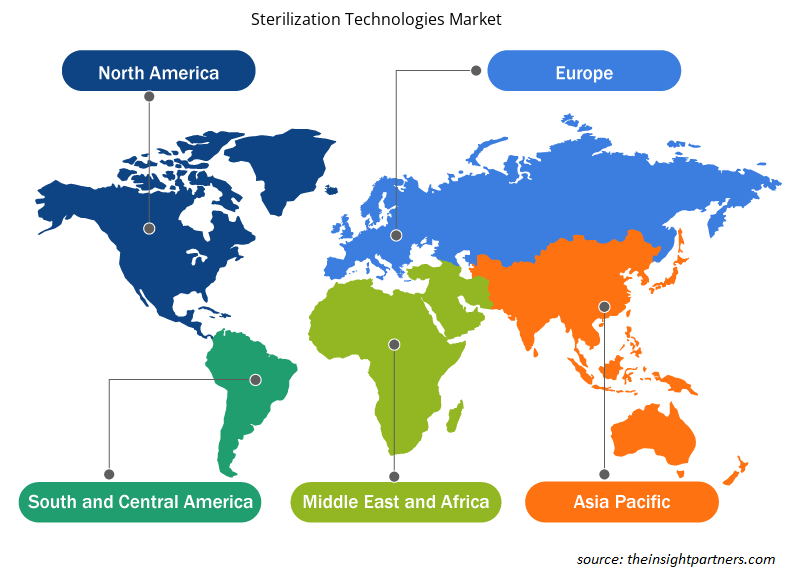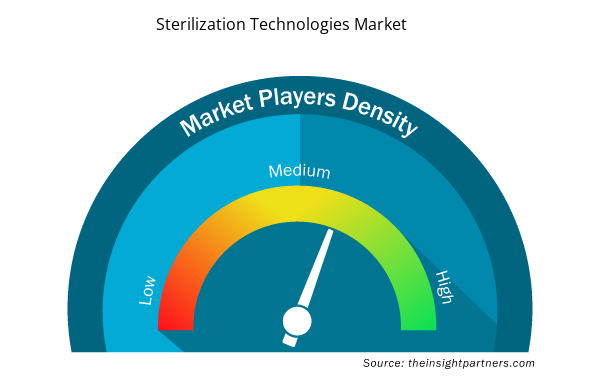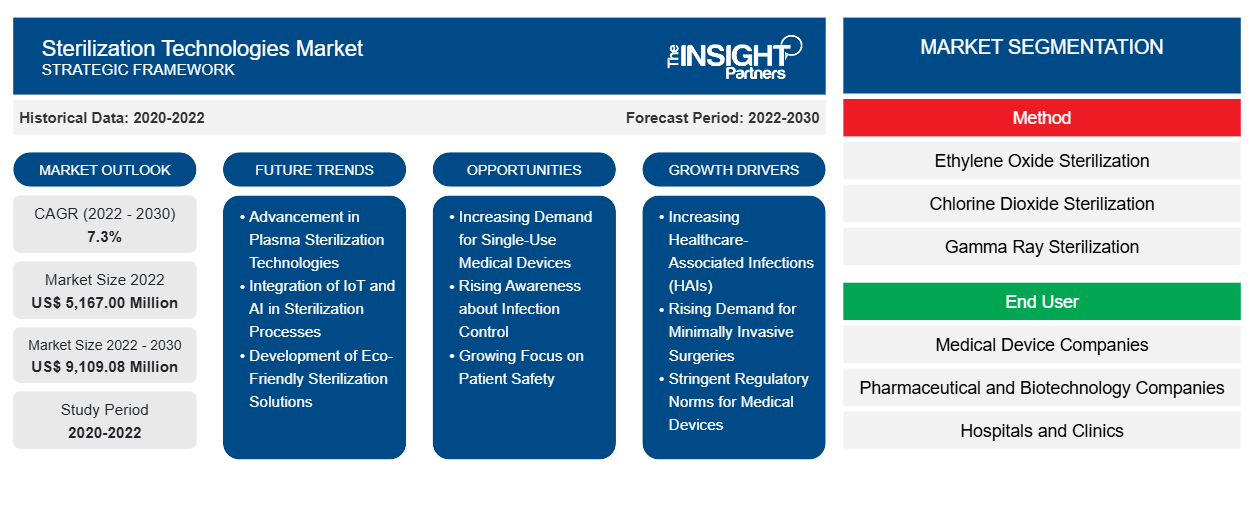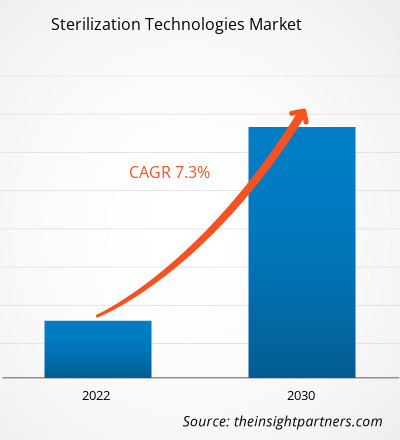[Forschungsbericht] Der Markt für Sterilisationstechnologien soll von 5.167,00 Millionen US-Dollar im Jahr 2022 auf 9.109,08 Millionen US-Dollar im Jahr 2030 wachsen; für den Zeitraum 2022–2030 wird eine durchschnittliche jährliche Wachstumsrate (CAGR) von 7,3 % erwartet.CAGR of 7.3% during 2022–2030.
Markteinblicke und Analystenansichten:
Der Bericht enthält Wachstumsaussichten aufgrund der aktuellen Markttrends für Sterilisationstechnologien und ihrer vorhersehbaren Auswirkungen während des Prognosezeitraums. Die Marktprognose für Sterilisationstechnologien kann den Beteiligten in diesem Markt bei der Planung ihrer Wachstumsstrategien helfen. Faktoren wie die zunehmende Verbreitung von im Gesundheitswesen erworbenen Infektionen und die steigende Zahl chirurgischer Eingriffe treiben das Marktwachstum voran. Die Schließung von Sterilisationseinrichtungen für medizinische Geräte behindert jedoch das Wachstum des Marktes.Darüber hinaus ist zu erwarten, dass die kontinuierliche Weiterentwicklung der Sterilisationstechnologien in den kommenden Jahren neue Trends auf dem Markt mit sich bringen wird.
Wachstumstreiber:
Die zunehmende Verbreitung von im Gesundheitswesen erworbenen Infektionen treibt das Wachstum des Marktes für Sterilisationstechnologien voran
Die Prävalenz von im Gesundheitswesen erworbenen Infektionen (HAIs) nimmt aufgrund unzureichender Ausrüstung, unzureichender Hygienebedingungen, schlechter Infrastruktur, begrenzter Sterilisationsrichtlinien und mangelnder Kenntnisse über Infektionskontrollmaßnahmen zu. Laut dem 2021 National and State HAIs Progress Report über standardisierte Infektionsverhältnisse, der von den Centers for Disease Control and Prevention (CDC) veröffentlicht wurde, meldeten Akutkrankenhäuser einen Anstieg der beatmungsassoziierten Ereignisse um 12 %, eine Zunahme der Methicillin-resistenten Staphylococcus aureus-Bakteriämie um 14 %, einen Anstieg der zentralvenösen Venenkatheter-assoziierten Blutstrominfektionen um 7 %, einen Anstieg der Fälle von Wundinfektionen (SSI) um 11 % und einen Anstieg der katheterassoziierten Harnwegsinfektionen (UTIs) um 5 %. Laut einer Kohortenstudie mit dem Titel „Clinical and economic burden of healthcare-associated infections“, die 2023 im National Center for Biotechnology Information (NCBI) veröffentlicht wurde, beträgt die Gesamtprävalenz von HAIs in Entwicklungsländern bis zu 15,5 %. Darüber hinaus liegt die Prävalenz bei schwerkranken Patienten Berichten zufolge bei 34,1 %.
Zu den am weitesten verbreiteten therapierbaren Infektionen (HAI) aufgrund unzureichender Sterilisationsverfahren gehören postoperative Infektionskrankheiten (SSI), Hepatitis B und C, Harnwegs- und Gefäßkatheterinfektionen, HIV-Infektionen und beatmungsassoziierte Infektionen. Diese Infektionen führen zu mehr Leiden der Patienten, längeren Krankenhausaufenthalten und höheren Behandlungskosten. Laut MDPI kosten therapierbare Infektionen die US-Wirtschaft jährlich etwa 10–33 Milliarden US-Dollar, in Europa sind es über 8,2 Milliarden US-Dollar (7 Milliarden Euro). Laut WHO ziehen sich in Entwicklungsländern 10 % bzw. 7 % der Krankenhauspatienten mindestens eine therapierbare Infektion zu. Außerdem ist die Zahl der auf der Intensivstation erworbenen Infektionen in Ländern mit niedrigem und mittlerem Einkommen etwa zwei- bis dreimal höher als in Ländern mit hohem Einkommen. In Ländern mit hohem Einkommen sind etwa 30 % der Patienten mit mindestens einer therapierbaren Infektion von auf der Intensivstation erworbenen Infektionen betroffen. Ebenso sind Neugeborene in Entwicklungsländern 20-mal anfälliger für diese Infektionen als in Industrieländern. Unzureichende oder unangemessene Sterilisation von chirurgischen Instrumenten und wiederverwendbaren Gegenständen erhöht das Risiko einer Ansteckung mit HAIs. Die zunehmende Verbreitung von HAIs fördertdas Wachstum des Marktes für Sterilisationstechnologien.
Passen Sie diesen Bericht Ihren Anforderungen an
Sie erhalten kostenlose Anpassungen an jedem Bericht, einschließlich Teilen dieses Berichts oder einer Analyse auf Länderebene, eines Excel-Datenpakets sowie tolle Angebote und Rabatte für Start-ups und Universitäten.
- Holen Sie sich die wichtigsten Markttrends aus diesem Bericht.Dieses KOSTENLOSE Beispiel umfasst eine Datenanalyse von Markttrends bis hin zu Schätzungen und Prognosen.
Berichtssegmentierung und -umfang:
Die „Marktanalyse für Sterilisationstechnologien“ wurde unter Berücksichtigung der folgenden Segmente durchgeführt: Methode und Endbenutzer.Nach Methode ist der Markt in Ethylenoxid-Sterilisation, Chlordioxid- Sterilisation, Gammastrahlen-Sterilisation, Elektronenstrahl-Sterilisation, Dampfsterilisation und andere unterteilt. Das Segment der Ethylenoxid-Sterilisation hatte 2022 den größten Marktanteil bei Sterilisationstechnologien. Das Segment der Chlordioxid-Sterilisation wird voraussichtlich zwischen 2022 und 2030 die höchste durchschnittliche jährliche Wachstumsrate verzeichnen.
Der Markt ist nach Endverbraucher unterteilt in Medizintechnikunternehmen, Pharma- und Biotechnologieunternehmen, Krankenhäuser und Kliniken, Labore und andere. Das Segment der Medizintechnikunternehmen hatte 2022 den größten Marktanteil bei Sterilisationstechnologien. Es wird erwartet, dass es zwischen 2022 und 2030 die höchste durchschnittliche jährliche Wachstumsrate verzeichnet.
Regionale Analyse:
Der geografische Umfang des globalen Marktberichts zu Sterilisationstechnologien ist in Nordamerika, Europa, den asiatisch-pazifischen Raum, Süd- und Mittelamerika sowie den Nahen Osten und Afrika unterteilt.Im Jahr 2022Nordamerika hatte den größten Marktanteil. Ein Anstieg der HAI-Fälle aufgrund kontaminierter Instrumente und fehlender Präventivmaßnahmen ist der Hauptfaktor, der die Nachfrage nach Sterilisationstechnologien in Gesundheitseinrichtungen in den USA antreibt. Laut den Centers for Disease Control and Prevention (CDC) infizierte sich im Jahr 2022 etwa 1 von 31 amerikanischen Patienten und 1 von 43 Pflegeheimbewohnern täglich mit mindestens einer HAI. Laut CDC sind jährlich mehr als 1,7 Millionen Infektionen und 99.000 damit verbundene Todesfälle auf HAIs zurückzuführen. Diese Schätzungen zeigen, dass die Patientenversorgung in Gesundheitseinrichtungen in den USA verbessert werden muss.
Die Nachfrage nach Sterilisationsprodukten wächst in den USA stark. Als Reaktion auf das Bewusstsein für Sterilisation bringen verschiedene Marktführer ihre Produkte auf den Markt. Im April 2020 erhielt Advanced Sterilization Products (US) die Notfallzulassung (EUA) der FDA für seine STERRAD-Sterilisatoren. Das Produkt ermöglicht es Gesundheitsdienstleistern, N95-Atemschutzmasken mithilfe von STERRAD-Sterilisationszyklen in Krankenhäusern zu dekontaminieren.
Regionale Einblicke in den Markt für Sterilisationstechnologien
Die regionalen Trends und Faktoren, die den Markt für Sterilisationstechnologien im Prognosezeitraum beeinflussen, wurden von den Analysten von Insight Partners ausführlich erläutert. In diesem Abschnitt werden auch die Marktsegmente und die Geografie von Sterilisationstechnologien in Nordamerika, Europa, im asiatisch-pazifischen Raum, im Nahen Osten und Afrika sowie in Süd- und Mittelamerika erörtert.

- Erhalten Sie regionale Daten zum Markt für Sterilisationstechnologien
Umfang des Marktberichts zu Sterilisationstechnologien
| Berichtsattribut | Details |
|---|---|
| Marktgröße im Jahr 2022 | 5.167,00 Millionen US-Dollar |
| Marktgröße bis 2030 | 9.109,08 Millionen US-Dollar |
| Globale CAGR (2022 - 2030) | 7,3 % |
| Historische Daten | 2020-2022 |
| Prognosezeitraum | 2022–2030 |
| Abgedeckte Segmente | Nach Methode
|
| Abgedeckte Regionen und Länder | Nordamerika
|
| Marktführer und wichtige Unternehmensprofile |
|
Dichte der Marktteilnehmer im Bereich Sterilisationstechnologien: Deren Auswirkungen auf die Geschäftsdynamik verstehen
Der Markt für Sterilisationstechnologien wächst rasant, angetrieben durch die steigende Nachfrage der Endnutzer aufgrund von Faktoren wie sich entwickelnden Verbraucherpräferenzen, technologischen Fortschritten und einem größeren Bewusstsein für die Vorteile des Produkts. Mit steigender Nachfrage erweitern Unternehmen ihr Angebot, entwickeln Innovationen, um die Bedürfnisse der Verbraucher zu erfüllen, und nutzen neue Trends, was das Marktwachstum weiter ankurbelt.
Die Marktteilnehmerdichte bezieht sich auf die Verteilung der Firmen oder Unternehmen, die in einem bestimmten Markt oder einer bestimmten Branche tätig sind. Sie gibt an, wie viele Wettbewerber (Marktteilnehmer) in einem bestimmten Marktraum im Verhältnis zu seiner Größe oder seinem gesamten Marktwert präsent sind.
Die wichtigsten auf dem Markt für Sterilisationstechnologien tätigen Unternehmen sind:
- Advanced Sterilization Products Services Inc
- Atec Pharmatechnik GmbH
- Belimed Inc
- Steris Plc
- Andersen Sterilizers Inc
Haftungsausschluss : Die oben aufgeführten Unternehmen sind nicht in einer bestimmten Reihenfolge aufgeführt.

- Überblick über die wichtigsten Akteure auf dem Markt für Sterilisationstechnologien
Branchenentwicklungen und zukünftige Chancen:
Nachfolgend sind einige strategische Entwicklungen führender Akteure aufgeführt, die zur Ausweitung des Marktes für Sterilisationstechnologien beitragen:
- Im August 2023 genehmigte die FDA das Niedertemperatur-Sterilisationssystem Steris V-PRO maX 2 mit einem Spezialzyklus für die Sterilisation von 3D-gedruckten Geräten, die in Gesundheitseinrichtungen verwendet werden. Dies ist das erste von der FDA zugelassene System, das chirurgische Instrumente wie patientenspezifische chirurgische Führungen (z. B. Osteotomie, Schulter, Hüfte, Knie und Wirbelsäule) und 3D-gedruckte anatomische Modelle, die für den einmaligen Gebrauch bei operativen Eingriffen bestimmt sind, effektiv sterilisieren kann.
- Im Juni 2023 arbeitete Shimadzu Corporation mit Shyld, einem in den USA ansässigen Experten für künstliche Intelligenz (KI) und Robotik, zusammen, um eine KI-gestützte Desinfektionstechnologie mit ultravioletter Bestrahlung C (UV-C) zu entwickeln. Die Technologie zielt darauf ab, die Landschaft der Infektionskontrolle neu zu definieren, indem sie die Optik von Shimadzu und die KI-Innovationen von Shyld kombiniert.
- Im Mai 2023 brachte Ahlstrom Reliance Fusion auf den Markt, eine Sterilisationsfolie der nächsten Generation, die die Effizienz der Sterilisation von Operationsbesteck in Krankenhäusern steigert. Reliance Fusion integriert hochwertige Materialien auf Zellulose- und Polypropylenbasis.
- Im Februar 2021 brachte XECH STEROSTET auf den Markt, Indiens ersten mit UV-C GI-Technologie betriebenen Stethoskop-Sterilisator. Dieses Produkt verwendet eine spezielle UV-C GI-Technologie, um Stethoskopmembranen aller Größen mit einer Wirksamkeit von bis zu 99,9999 % zu sterilisieren. Mithilfe dieser Spitzentechnologie kann das Stethoskop beim Wechsel von einem Patienten zum anderen in weniger als 5 Minuten sterilisiert werden. Der STEROSTET verfügt außerdem über integrierte intelligente Sensoren, die eine problemlose, sichere und reibungslose und schnelle Sterilisation des Stethoskops gewährleisten.
Wettbewerbslandschaft und Schlüsselunternehmen:
Advanced Sterilization Products Services Inc, Steris Plc, Atec Pharmatechnik GmbH, Belimed Inc, Andersen Sterilizers Inc, Consolidated Machine Corp, Sterile Technologies Inc, Tuttnauer, BMT Medical Technology SRO und Steelco SpA gehören zu den führenden Unternehmen, die im Marktbericht zu Sterilisationstechnologien vorgestellt werden. Diese Unternehmen konzentrieren sich auf die Entwicklung neuer Technologien, die Verbesserung bestehender Produkte und die Ausweitung ihrer geografischen Präsenz, um der wachsenden weltweiten Verbrauchernachfrage gerecht zu werden.
- Historische Analyse (2 Jahre), Basisjahr, Prognose (7 Jahre) mit CAGR
- PEST- und SWOT-Analyse
- Marktgröße Wert/Volumen – Global, Regional, Land
- Branche und Wettbewerbsumfeld
- Excel-Datensatz



Report Coverage
Revenue forecast, Company Analysis, Industry landscape, Growth factors, and Trends

Segment Covered
This text is related
to segments covered.

Regional Scope
North America, Europe, Asia Pacific, Middle East & Africa, South & Central America

Country Scope
This text is related
to country scope.
Häufig gestellte Fragen
The sterilization technologies market majorly consists of the players, including Advanced Sterilization Products Services Inc, Steris Plc, Atec Pharmatechnik GmbH, Belimed Inc, Andersen Sterilizers Inc, Consolidated Machine Corp, Sterile Technologies Inc, Tuttnauer, BMT Medical Technology SRO, and Steelco SpA
The market, by end user, is divided into medical device companies, pharmaceutical and biotechnology companies, hospitals and clinics, laboratories, and others. The medical device companies segment held the largest sterilization technologies market share in 2022. It is anticipated to register the highest CAGR during 2022–2030.
Sterilization technologies are widely used to reduce microorganisms that may remain on the surfaces after a standard cleaning to the minimum number.
Factors such as the increasing prevalence of healthcare-associated infections and the rising number of surgical procedures propel the market growth.
The sterilization technologies market was valued at US$ 5,167.00 million in 2022.
The sterilization technologies market is expected to be valued at US$ 9,109.08 million in 2030.
By method, the market is segmented into ethylene oxide sterilization, chlorine dioxide sterilization, gamma ray sterilization, electron beam sterilization, steam sterilization, and others. The ethylene oxide sterilization segment held the largest sterilization technologies market share in 2022. The chlorine dioxide sterilization segment is anticipated to register the highest CAGR during 2022–2030.
Trends and growth analysis reports related to Life Sciences : READ MORE..
The List of Companies - Sterilization Technologies Market
- Advanced Sterilization Products Services Inc
- Atec Pharmatechnik GmbH
- Belimed Inc
- Steris Plc
- Andersen Sterilizers Inc
- Consolidated Machine Corp
- Sterile Technologies Inc.
- Tuttnauer
- BMT Medical Technology SRO
- Steelco SpA
The Insight Partners performs research in 4 major stages: Data Collection & Secondary Research, Primary Research, Data Analysis and Data Triangulation & Final Review.
- Data Collection and Secondary Research:
As a market research and consulting firm operating from a decade, we have published and advised several client across the globe. First step for any study will start with an assessment of currently available data and insights from existing reports. Further, historical and current market information is collected from Investor Presentations, Annual Reports, SEC Filings, etc., and other information related to company’s performance and market positioning are gathered from Paid Databases (Factiva, Hoovers, and Reuters) and various other publications available in public domain.
Several associations trade associates, technical forums, institutes, societies and organization are accessed to gain technical as well as market related insights through their publications such as research papers, blogs and press releases related to the studies are referred to get cues about the market. Further, white papers, journals, magazines, and other news articles published in last 3 years are scrutinized and analyzed to understand the current market trends.
- Primary Research:
The primarily interview analysis comprise of data obtained from industry participants interview and answers to survey questions gathered by in-house primary team.
For primary research, interviews are conducted with industry experts/CEOs/Marketing Managers/VPs/Subject Matter Experts from both demand and supply side to get a 360-degree view of the market. The primary team conducts several interviews based on the complexity of the markets to understand the various market trends and dynamics which makes research more credible and precise.
A typical research interview fulfils the following functions:
- Provides first-hand information on the market size, market trends, growth trends, competitive landscape, and outlook
- Validates and strengthens in-house secondary research findings
- Develops the analysis team’s expertise and market understanding
Primary research involves email interactions and telephone interviews for each market, category, segment, and sub-segment across geographies. The participants who typically take part in such a process include, but are not limited to:
- Industry participants: VPs, business development managers, market intelligence managers and national sales managers
- Outside experts: Valuation experts, research analysts and key opinion leaders specializing in the electronics and semiconductor industry.
Below is the breakup of our primary respondents by company, designation, and region:

Once we receive the confirmation from primary research sources or primary respondents, we finalize the base year market estimation and forecast the data as per the macroeconomic and microeconomic factors assessed during data collection.
- Data Analysis:
Once data is validated through both secondary as well as primary respondents, we finalize the market estimations by hypothesis formulation and factor analysis at regional and country level.
- Macro-Economic Factor Analysis:
We analyse macroeconomic indicators such the gross domestic product (GDP), increase in the demand for goods and services across industries, technological advancement, regional economic growth, governmental policies, the influence of COVID-19, PEST analysis, and other aspects. This analysis aids in setting benchmarks for various nations/regions and approximating market splits. Additionally, the general trend of the aforementioned components aid in determining the market's development possibilities.
- Country Level Data:
Various factors that are especially aligned to the country are taken into account to determine the market size for a certain area and country, including the presence of vendors, such as headquarters and offices, the country's GDP, demand patterns, and industry growth. To comprehend the market dynamics for the nation, a number of growth variables, inhibitors, application areas, and current market trends are researched. The aforementioned elements aid in determining the country's overall market's growth potential.
- Company Profile:
The “Table of Contents” is formulated by listing and analyzing more than 25 - 30 companies operating in the market ecosystem across geographies. However, we profile only 10 companies as a standard practice in our syndicate reports. These 10 companies comprise leading, emerging, and regional players. Nonetheless, our analysis is not restricted to the 10 listed companies, we also analyze other companies present in the market to develop a holistic view and understand the prevailing trends. The “Company Profiles” section in the report covers key facts, business description, products & services, financial information, SWOT analysis, and key developments. The financial information presented is extracted from the annual reports and official documents of the publicly listed companies. Upon collecting the information for the sections of respective companies, we verify them via various primary sources and then compile the data in respective company profiles. The company level information helps us in deriving the base number as well as in forecasting the market size.
- Developing Base Number:
Aggregation of sales statistics (2020-2022) and macro-economic factor, and other secondary and primary research insights are utilized to arrive at base number and related market shares for 2022. The data gaps are identified in this step and relevant market data is analyzed, collected from paid primary interviews or databases. On finalizing the base year market size, forecasts are developed on the basis of macro-economic, industry and market growth factors and company level analysis.
- Data Triangulation and Final Review:
The market findings and base year market size calculations are validated from supply as well as demand side. Demand side validations are based on macro-economic factor analysis and benchmarks for respective regions and countries. In case of supply side validations, revenues of major companies are estimated (in case not available) based on industry benchmark, approximate number of employees, product portfolio, and primary interviews revenues are gathered. Further revenue from target product/service segment is assessed to avoid overshooting of market statistics. In case of heavy deviations between supply and demand side values, all thes steps are repeated to achieve synchronization.
We follow an iterative model, wherein we share our research findings with Subject Matter Experts (SME’s) and Key Opinion Leaders (KOLs) until consensus view of the market is not formulated – this model negates any drastic deviation in the opinions of experts. Only validated and universally acceptable research findings are quoted in our reports.
We have important check points that we use to validate our research findings – which we call – data triangulation, where we validate the information, we generate from secondary sources with primary interviews and then we re-validate with our internal data bases and Subject matter experts. This comprehensive model enables us to deliver high quality, reliable data in shortest possible time.


 Holen Sie sich ein kostenloses Muster für diesen Bericht
Holen Sie sich ein kostenloses Muster für diesen Bericht